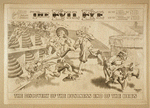Today's quote for this multi-part series on Hair is taken from Helen Sheumaker's fascinating study, Love Entwined: The Curious History of Hairwork in America. This study traces the rise and fall of hairwork (hair jewelry, wreaths, portrait miniatures including locks of hair) as an object of sentiment and devotion as the once hand-made fanciwork became increasingly commercialized:
In the eighteenth century, the sentimental associations of hair were obliquely displayed; by the nineteenth century, hairwork and the sentimentality it conveyed was worn for others to observe. This practice revealed a paradox about sentimentality. While display of one's sentimentality was essential to being regarded as sentimental, that same exhibition could easily be construed as ostentatious, vulgar, and insincere. Fashion was constantly in flux, it was superficial, and it was self-aggrandizing. It opposed the sincerity that women in particular were supposed to possess. Fashion was expressed with goods, and therefore was opposed to the domestic sphere. Thus, those constant fluctuations in styles threatened to undermine the premise of sentimentality itself.
Even as hairwork revealed the dissonance between genuine emotion and frivolous fashionableness, it attempted a remedy. Hair's undeniable relationship to an individual asserted a sincerity of character that transcended the hypocrisy that fahionableness implied. The mid-nineteenth century was the height of the popularity of hairwork perhaps because as fashion was criticized as being particularly hypocritical, hairwork's genuiness was being asserted. On the one hand, hair jewelry was very much a commodity, buttressed as it was by marketing and salesmanship; on the other hand, it was exactly that which could not be completely commodified. Hair jewelry provided a way to forestall the apparent effects of fashion in the market and in the social world" (20-21).
--Helen Sheumaker, Love Entwined: The Curious History of Hairwork in America, (2007)
Saturday, October 10, 2009
Hair Part II: Pieces of Me
Labels:
crafts/fanciwork,
death,
domesticity,
fashion,
gifts,
hair,
jewelry,
keepsakes/talismans,
relics,
sentiment
Subscribe to:
Post Comments (Atom)






No comments:
Post a Comment